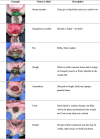Healing progression of tail docking and ear tag wounds in lambs
- PMID: 39856152
- PMCID: PMC11760940
- DOI: 10.1038/s41598-025-86204-7
Healing progression of tail docking and ear tag wounds in lambs
Abstract
Tail docking and ear tagging are common husbandry practices in lambs, but little is known about subsequent wound healing or how it may be affected by performing both procedures concurrently. Our objectives were to: (1) describe wound healing following tail docking and ear tagging, and (2) compare healing of ear wounds in docked and undocked lambs. Within 28 female Polypay twin pairs, one lamb was docked using a rubber ring between 1 and 2 days of age and the other lamb's tail was left intact. Tags were attached to both ears of all lambs. We photographed tail and ear wounds twice weekly until weaning (mean ± SD; 64 ± 5 days of age). Tail wounds took 43 ± 9 days to heal (range: 30-60 days). Pus, a sign of infection, was present at least once in 89% of tail wounds and was associated with delayed healing. Only 49% of ear wounds had healed by weaning, and tail docking did not predict the probability of healing. Pus and sanguineous exudate (i.e., bleeding) were present at least once in 21% and 96% of ear wounds, respectively. Pus was not associated with the probability of ear wound healing, but ears with more frequent bleeding were less likely to have healed by weaning. The duration of healing and likelihood of infection following both procedures raise welfare concerns and suggest refinements or alternatives are warranted.
Keywords: Animal welfare; Infection; Painful procedures; Sheep; Wound healing.
© 2025. The Author(s).
Conflict of interest statement
Declarations. Competing interests: The authors declare no competing interests.
Figures







Similar articles
-
Topical anaesthesia alleviates short-term pain of castration and tail docking in lambs.Aust Vet J. 2010 Mar;88(3):67-74. doi: 10.1111/j.1751-0813.2009.00546.x. Aust Vet J. 2010. PMID: 20402687
-
Practices and opinions of New Zealand sheep farmers towards pain management in lambs during castration and/or tail docking.N Z Vet J. 2023 Jan;71(1):8-17. doi: 10.1080/00480169.2022.2135626. Epub 2022 Nov 11. N Z Vet J. 2023. PMID: 36222478
-
Acute cortisol responses and wound healing in lambs after ring castration plus docking with or without application of a castration clamp to the scrotum.Aust Vet J. 2000 Jun;78(6):402-5. doi: 10.1111/j.1751-0813.2000.tb11827.x. Aust Vet J. 2000. PMID: 10920779
-
Fat-tailed sheep traits as affected by docking.Trop Anim Health Prod. 2003 Aug;35(4):351-63. doi: 10.1023/a:1025145422243. Trop Anim Health Prod. 2003. PMID: 14509541 Review.
-
Welfare implications of invasive piglet husbandry procedures, methods of alleviation and alternatives: a review.N Z Vet J. 2015 Jan;63(1):52-7. doi: 10.1080/00480169.2014.961990. Epub 2014 Dec 11. N Z Vet J. 2015. PMID: 25204203 Review.
Cited by
-
Novel Gels for Post-Piercing Care: Evaluating the Efficacy of Pranoprofen Formulations in Reducing Inflammation.Gels. 2025 Apr 30;11(5):334. doi: 10.3390/gels11050334. Gels. 2025. PMID: 40422354 Free PMC article.
References
-
- Orihuela, A. & Ungerfeld, R. Tail docking in sheep (Ovis aries): A review on the arguments for and against the procedure, advantages/disadvantages, methods, and new evidence to revisit the topic. Livest. Sci.230, 103837. 10.1016/j.livsci.2019.103837 (2019).
-
- French, N. P. & Morgan, K. L. Neuromata in docked lambs’ tails. Res. Vet. Sci.52, 389–390. 10.1016/0034-5288(92)90045-4 (1992). - PubMed
-
- United States Department of Agriculture (USDA). Sheep 2011: Part IV: Changes in Health and Production Practices in the U.S. Sheep Industry, 1996–2011. 64–65; (2014). https://www.aphis.usda.gov/livestock-poultry-disease/nahms/sheep
-
- Ware, J. W., Vizard, A. & Lean, G. Effects of tail amputation and treatment with an albendazole controlled-release capsule on the health and productivity of prime lambs. Aust Vet. J.78, 838–842. (2000). - PubMed
-
- Soriano, V., Stamm, F., Taconeli, C. & Molento, C. To dock or not to dock? Faecal soiling measurement in sheep. Anim. Welf.29, 81–87. 10.7120/09627286.29.1.081 (2020).
Publication types
MeSH terms
Grants and funding
LinkOut - more resources
Full Text Sources

